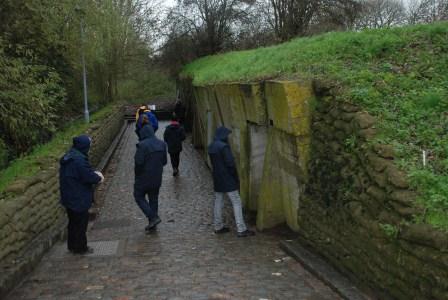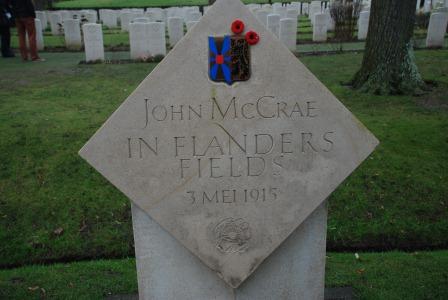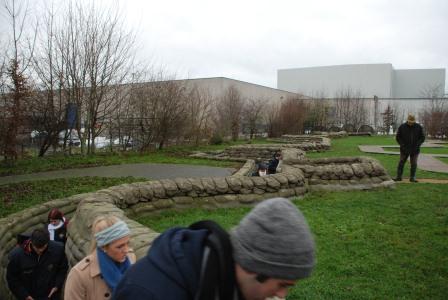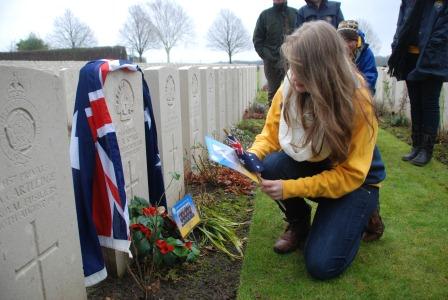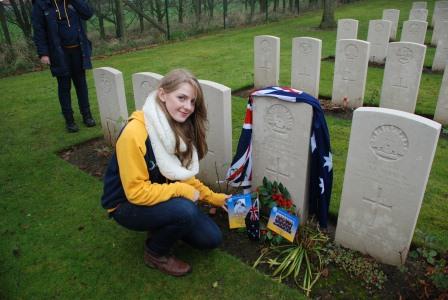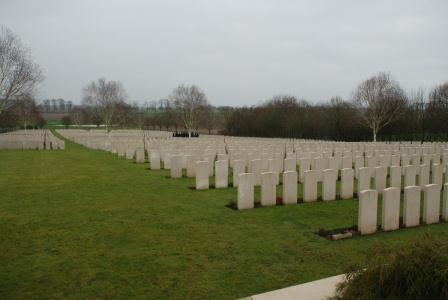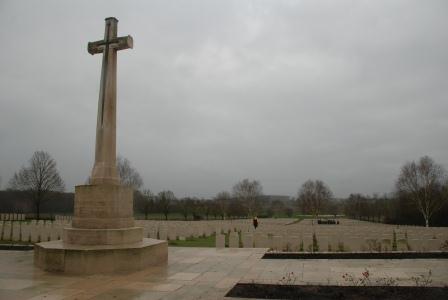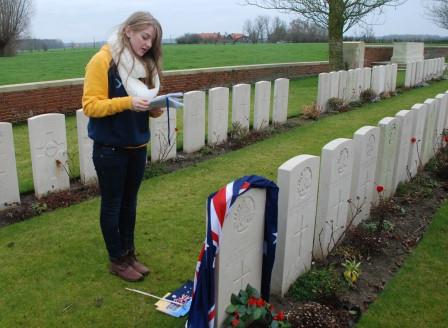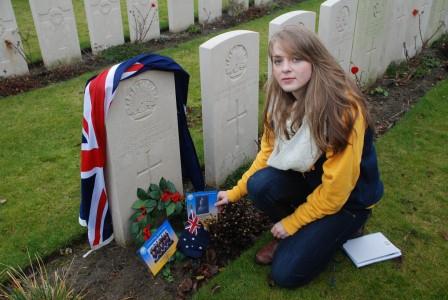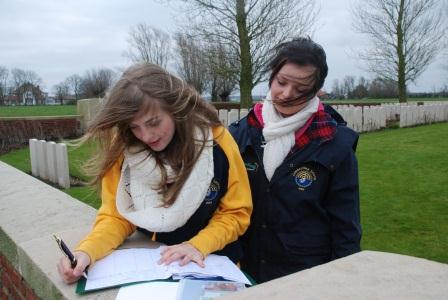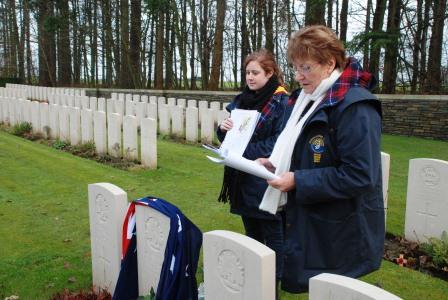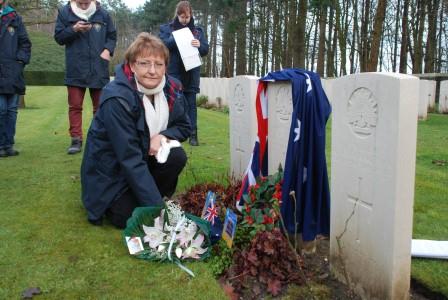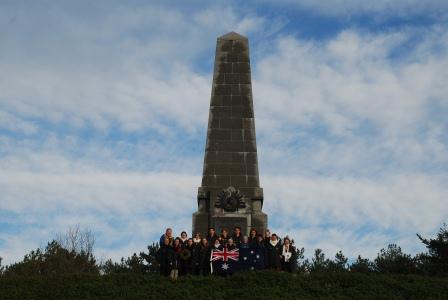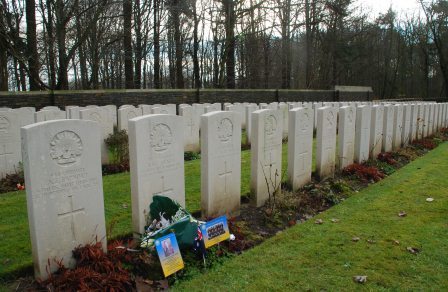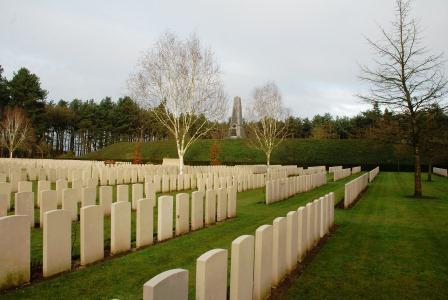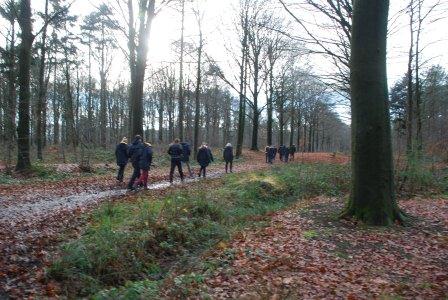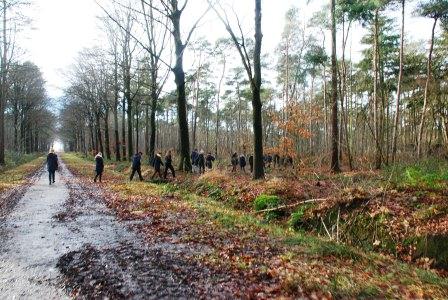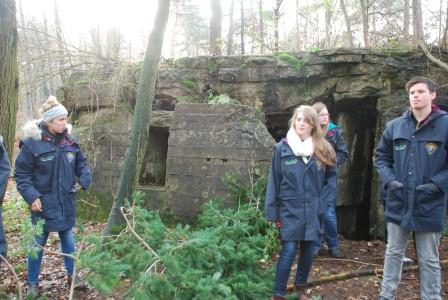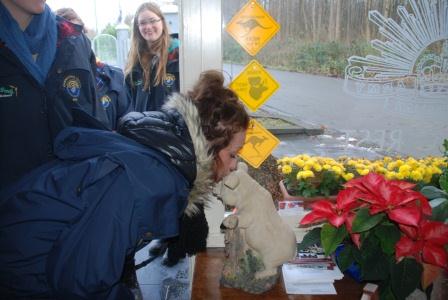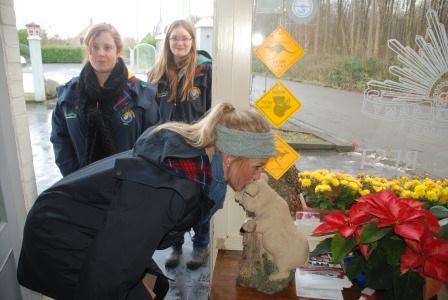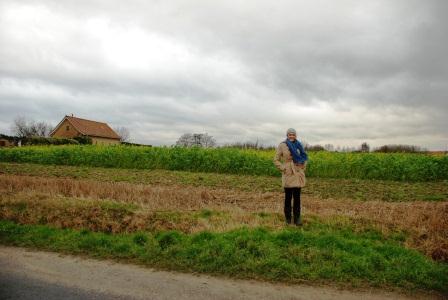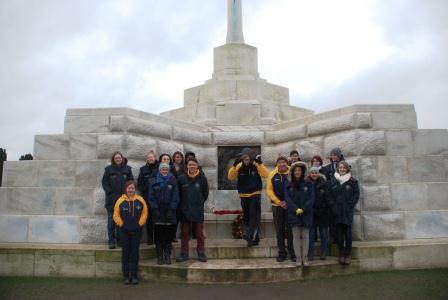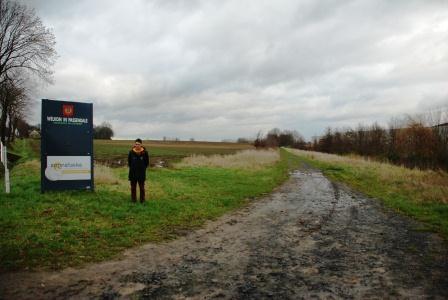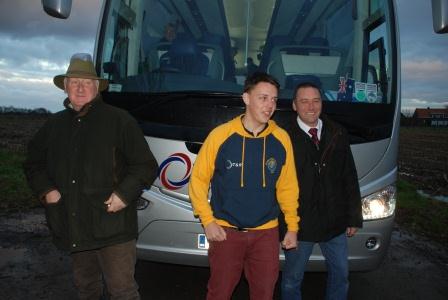9th December
ESSEX FARM, MENIN ROAD, POLYGON WOOD AND PASSCHENDAELE
Today started a bit later than normal at 9.30am and we made our way back towards Poperinghe to visit the grave of Noel Chavasse, the only double VC winner in World War 1 and only one of three to have won two VC's in history. He was a medical officer and won the award for bravery and devotion to duty in rescuing and treating wounded men in extreme conditions and under heavy enemy fire. We then moved to Essex Farm to see where John McRae wrote his poem "In Flanders Fields" in 1915. We had visited his grave a week before even though it felt like years ago. Verity read the poem to the group and then we looked through the dressing station where he was working at that time. From here we stopped at a small area of trenches and tunnels that had been dug up and surveyed by Johaan Vandewalle many years ago. Thanks to road closures we zigzagged across the battlefields so that Alysha could commemorate two soldiers. The first was Thomas Spurr in Hooge Crater Cemetery. He has been commemorated in every Connecting Spirits tour, as he is related to the Rowe family, and Alysha continued a proud tradition for her very close friends, reading a poem written by Michelle Rowe. We then travelled to the Aeroplane Cemetery where she commemorated John George Eckert, her own relative, who has also been commemorated on all four CS trips. Just as it had for her two older brothers, this commemoration brought out the best in her and she told his story with dignity and style, and a tear in her eye.
Alysha Eckert
When I saw his headstone something grabbed me in my stomach. The name, our name, Eckert forever carved in the white stone. My hands started to shake as the enormity of what I saw surrounding me from every direction hit. Walking amongst the many white stones is one thing; then you see the name the one you know so much about and it is something else entirely.
Alana Standley
A very special day. Alysha's commemorations touched me, as I shed a tear for them both. However, her commemoration to her great grandfather's cousin affected me the most. As soon as I saw the Eckert name on the headstone, I got chills. I couldn't even imagine what that must of felt like for Alysha. As she started to commemorate him, I imagined her brothers commemorating him in the past years. This is why Connecting Spirits is so special. It offers the opportunity to families to commemorate their relatives, when sometimes the grave of the soldier has never been visited by their family members before. As Alysha said in her commemoration, it doesnt matter how many times one soldier is commemorated. It only shows the commitment that family has to remembering their fallen. The reason I got so emotional in Alysha's commemorations, is that I have a huge respect for her family. And to see Alysha's emotions build up to the point of crying, made me very emotional. It was like I was watching my own sister stand up there, and in saying that I am very proud of her!
We then travelled up through the Passchendaele Ridge area and came into Polygon Wood from the back. It is here that Julie's Great Uncle Marty is buried, the men that inspired her to start this whole journey many years ago. This time her commemoration would be different. She read extracts from the book that she has written to help students connect with the history of this conflict, using her uncle as the source and inspiration. She read the first part on the bus and then, after we moved into the cemetery, she continued the story when a grandfather and grandson come to the final resting place of the uncle that they had talked to each other about for years. She felt that she was taking a risk, and perhaps she was, but it seemed that Uncle Marty was watching over her and it all worked. Even the wind in the trees picked up on cue.
Julie Reece
Having been to this place now many times with lots of groups, I wanted to do something special this time. Over the years I have had Marty’s story bubbling around in my head but haven’t ever quite known what to do with it. Years ago I attempted to write a novel and it was a total waste of time – it just didn’t go anywhere: I had no focus. This time it was different. Marty’s story would be told from the perspective of a 10 year old boy travelling with his grandfather on an Anzac pilgrimage. Jimmy the boy, and his Poppy would retrace the footsteps of their Great Uncle Marty using his precious postcards, photos, letters and service records as the compass for their travels. And so today I started my commemoration to James Martin Clement Neagle on the coach with a brief explanation of the book’s content. I had thought quite a bit about whether to take this approach by sharing part of the story with the group and felt it was risky. However I really wanted these kids to be the first audience to hear the story so I decided to proceed. I just hope they didn’t think it was a load of crap!
The story starts in Sutton Veny where our journey had begun just ten days ago. The Neagle brothers, like many others, spent time on the Salisbury Plains prior to being moved over to the battlefields of the Western Front. From there I led the group out to Buttes New British Cemetery on a parallel journey to Marty’s grave just as the two main characters do in the book. I felt nervous. Once I was behind his headstone as I had done so many times before, I then read out corresponding part of the narrative for my commemoration. Last night in my hotel room I did a practise run but ended up in tears through most of it all!!! I did not want that to happen today. So my beloved Marty’s true life story was told in this unconventional manner and I managed to get through it all without turning into a blubbering mess. I was happy: I hope my late mum Cathy would have been ok about it. She loved this man from 1917 so much as a little girl and if ‘Jimmy’s Anzac Pilgrimage’ it true to his memory then I have achieved what I set out to. I laid the flowers I bought from the Ypres flower shop on his resting place. Once again felt that sadness in my gut for my mother who never lived long enough to witness the impact her favourite uncle Marty has not only had on my life but on all the young ones who now come to pay homage to the man who began all that is ‘Connecting Spirits’ ….Private James Martin Clement Neagle 2233, 50th Battalion. KIA October 18, 1917. Rest in Peace Marty …you have not been forgotten.
Bianca Kahl
Hearing Julie read her book, about a grandfather and his grandson's journey to Sutton Veny at the start right up to the point when they were at the grave where we were standing helped me to reflect on our tour and helped make more connections to the previous places we had visited on our own journey.
Marni Hood
Today, Julie's reading of her short story was definitely a stand out. The way she managed to balance the educational and factual aspects of the war with a touching story that anyone can relate to. I enjoyed listening to her commemoration as it was quite different to the ones that we are used to.
Michael Mckechnie
The visit to Polygon Wood was special today. Starting with Julie's emotional commemoration to her great uncle; it was special to me as it was near here that my great great uncle Gustav Gerhardy was mortally wounded so it was a unique feeling walking through there.
Jack Bricknell
During the day we were told the story of several VC winners and one double VC winner. It was touching to learn the story of Noel Chavasse and how he saved over 20 men under shell fire and machine gun fire and even though he was wounded. On one trip he still kept going until he couldn't do any more. Then he died from his wounds. Then we were off to Polygon Wood and while there we did some scavenging for left over war artefacts and I found the tip of a bullet that still had its point and all. I will be taking this home with me so I can remember my time in Belgium.
After Julie's commemoration we had a group photo in front of the 5th Divisonal Memorial on the butte in the cemetery, and then walked through Polygon Wood to Johan Vandewalle's inn where lunch was waiting. Richard the bus driver was waiting for us there and as we walked in he told the students that it was a Belgian tradition to have a stone pig inside the front door and that you needed to kiss the pig when you enter a new house for the first time. Most of them fell for it aand Zac appeared to enjoy it a bit too much. Johan thought that this was a huge joke, but thought that if anything was going to get kissed by pretty girls coming into his inn it should be him. Lunch was a beautiful soup, which had some of the kids asking for seconds, and a massive ham and salad baguette. Awesome lunch... Johan then showed some pictures and displays of areas that he had been involved in excavating and some memoribila that he had been given by some very grateful relatives. He helped the producers of the film Beneath Hill 60 portray the story accurately.
After a relatively short time we were off and this time we drove past the site of Celtic Wood where one of Marni's soldiers was killed and his body never recovered. We then went to Tyne Cot , the largest Commonwealth War Graves Commission cemetery in the world with over 11000 burials and 35000 names of missing on the walls around it. It was cold but the students all listened intently to the stories of the two Australian VC winners buried here. We then headed to the German cemetery at Langemark. Unlike the Commonwealth soldiers, German soldiers tended to buried together in graves of 3 or 4 men; comrades in life, comrades in death. Added to this after World War 2, the French and Belgium governments were no longer willing to have huge numbers of German cemnteries dotted around the countryside, and so they designated a limited number of sites and told teh German government that the remains of their soldiers needed to be re-interred in these sites or repatriated back to Germany. Asa result each of the cemteries we visited had huge numbers of burials including mass graves of thousands of soldiers brought in from smaller cemeteries. Thus places like Langemark contain 40000 + burials plus 20000 - 30000 burials in mass graves and have a completely different feel to the CWGC cemeteries and memorials that we norrmally visit. Being South Australians with a rich German history, quite often we find the same names that we have commemorated as Australians in the German cemeteries. This and the sheer scale of death in these cemeteries really do bring home the reality of the tradegy and futility of war and the impact that it has on families on both sides of the conflict. On the way there we had stopped at the site where Rufus Rigney was wounded and captured, and Jake had his photo taken there. It was late and cold and time to get home.
Anne Molinaro
Visiting Tyne Cot was quite surreal seeing the rows of headstones. I tried to picture how large the cemetery would be if the names on teh walls had graves as well, but I couldn't imagine it. There was so much wasted life.
Tamika Williams
At one stage of this trip someone asked. How is your sight seeing going on your holiday? I was immediately drawn up in anger.
This trip is so emotionally draining. Standing there in the same conditions the soldiers did and listening to Rod, Jurgsy or Julie tell stories of the battles and the soldiers is truly a touching and amazing feeling. The rawness of this trip is incredible. One will never understand the proud and honourable moment when your reading your commemoration out either at a grave or memorial site, until they experience it for themselves. This trip will forever be in my heart and the stories I have learnt about will always be wedged firmly in my mind.
Demi Georgiou
I was quite surprised at the way I felt when I did my commemorations. I expected to be a lot more emotional and cry a lot but it wasn't like that at all for me. Though I still felt sadness for the soldiers lost I had a strong feeling of respect and pride. As a cadet I know what it's like to be in the cold, the rain and the mud. Not to the degree the soldiers felt obviously and not with the extreme danger but I can start to imagine the difficulties they went through and that just makes me feel so much respect for those that endured the terrible conditions.
Julie Reece
One week to go of the tour but only a few more days of commemorations. Yesterday I spoke of dad’s cousin Bruce Lyall Godfree and shared some new bits to his story – information dug up by my mate Judy Georgiou. Bruce was a student at Prince Alfred College and his teacher John Blackett was his officer. Bruce was killed in action on June 28, 1916 weeks before the Australians saw their first action on the western front at Fromelles on July 19. Bruce was stationed in the nursery sector waiting to be sent to the front line. On the night of the 28th we now know because of Jude’s research, that several artillery shells hit Bruce’s trench burying some of his mates, one of them a boy named Davies who was also a PAC lad. He tried to dig them out and in doing so was killed by another shell. Judy uncovered a poignant letter written by Blackett where he writes of losing ‘…two jolly fine boys…’ one of them the cousin of my dad. Several days later Blackett was also killed. So there in the La Plus Douve cemetery on a cold winter’s morning lay a teacher and two of his former students just a row apart. I looked at our lads and tried to process it all: I couldn’t.
Thanks Jude for filling in a bit more of this sad story.
Jake Shaw
Today we had a steady day. We had three commemorations by Julie and Alysha. They both did so well, they touched me deeply. We went to Essex farm where John McCrae wrote "In Flanders Fields". We also went to Polygon Wood where we did some exploring. I also tried to act like I was in the army and sneak up on Rod; it didn't work. Then we went to Johan's inn and had some really nice lunch. From there we travelled to Tyne Cot to see so many headstones!!! Not far from here we went to the spot where Rufus Rigney was wounded and captured. It was touching in so many ways knowing that I was standing near where a hero died!
Lauren Bagshaw
The time we spent in Polygon Wood was very significant, from Julie’s tear-jerking commemoration to the walk through the wood to see a bunker and remnants of the German front line. I found this cemetery to be quite beautiful due to its isolated location in the wood. However, I think this contributed to the eerie atmosphere it had; maybe it was just the dark sky and the cold breeze, but it seemed to be quite a sad place.
Lunch turned out to be quite interesting! Johan certainly has a personality; of course we kissed the pig, we weren’t going to rude to someone who was going to feed us! It was also great to see how devoted he is to researching the war activities that happened near his home.
Maybe it was the trees or the different angles of the headstones but Tyne Cot didn’t seem that big. I think that cemetery had a familiar feel to it, like we were home again, surrounded by good old Aussies. That’s what the word Commonwealth means to me; familiar people
